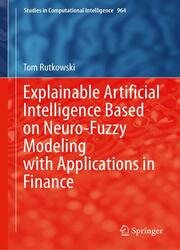 Название: Explainable Artificial Intelligence Based on Neuro-Fuzzy Modeling with Applications in Finance
Название: Explainable Artificial Intelligence Based on Neuro-Fuzzy Modeling with Applications in FinanceАвтор: Tom Rutkowski
Издательство: Springer
Год: 2021
Страниц: 175
Язык: английский
Формат: pdf (true), epub
Размер: 48.4 MB
The book proposes techniques, with an emphasis on the financial sector, which will make recommendation systems both accurate and explainable. The vast majority of Artificial Intelligence (AI) models work like black box models. However, in many applications, e.g., medical diagnosis or venture capital investment recommendations, it is essential to explain the rationale behind AI systems decisions or recommendations. Therefore, the development of Artificial Intelligence cannot ignore the need for interpretable, transparent, and explainable models. First, the main idea of the explainable recommenders is outlined within the background of neuro-fuzzy systems. In turn, various novel recommenders are proposed, each characterized by achieving high accuracy with a reasonable number of interpretable fuzzy rules. The main part of the book is devoted to a very challenging problem of stock market recommendations. An original concept of the explainable recommender, based on patterns from previous transactions, is developed; it recommends stocks that fit the strategy of investors, and its recommendations are explainable for investment advisers.
In recent years, the research community of Artificial Intelligence has focused primarily on increasing the performance of algorithms. Models based on deep neural networks have shown spectacularly good results, especially in image recognition, automatic text translation, and voice recognition. The use of Generative Adversarial Networks enabled the automatic generation of images and music. Thanks to the development of these techniques, we can observe enormous progress in medical diagnostics or autonomous cars. The problem is that these models work on the principle of “black boxes”. This means that while they perform very well, it is very difficult to justify exactly how they work. There are many cases where the lack of explanation is unacceptable because of the consequences of making the wrong decision. This may include medicine, law, finance, or the control of autonomous cars. In high-stakes, decision-making processes, people should require explanations with every recommendation or prediction regardless of the source of a recommendation—a human or a machine.
This book focuses on proposing techniques that will make recommendation systems both accurate and explainable with the emphasis on the financial sector because it is in particular very challenging from the perspective of data. Objectives are also different in Finance in comparison to general technological problems. The most popular tech problems are related to Image Recognition, Natural Language Processing, Computational Advertising, or Robotics. It is very different from solving specific problems in Finance regarding Forecasting, Valuation, Trading and Asset Management, or Decision-Making in Banking. Usually, in Finance, data are non-stationary, small or medium-size, and typically quite noisy. The uncertainty is high, as are the stakes, therefore interpretability of results is desired by end-users. Not to mention that explainability is more and more often required by regulators. Because of these reasons, it is essential to develop methods that can be used to solve problems with the above objectives and constraints. The author of this book believes and proves that using techniques based on the Neuro-Fuzzy approach is the way to go in such challenging cases.
Contents:
Скачать Explainable Artificial Intelligence Based on Neuro-Fuzzy Modeling with Applications in Finance
